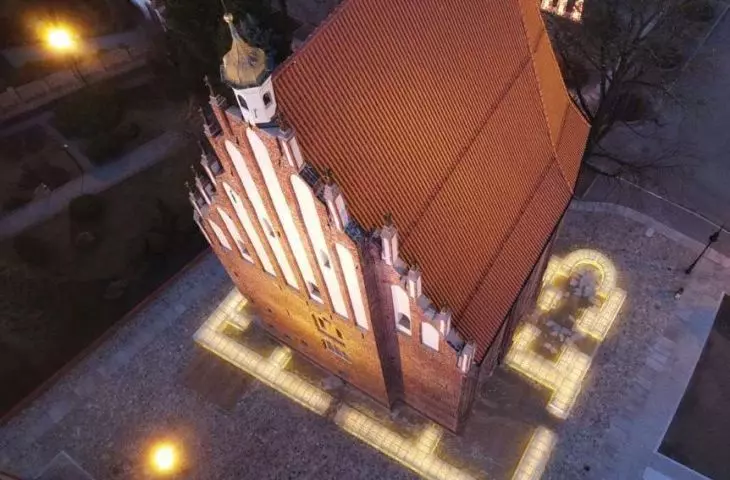It took a long time to make the most significant archaeological discoveries in Poznan visible. Finally, as of this year, the outline of the walls of Mieszko I's mid-10th century palatium, along with the adjacent chapel, is being exposed by means of a discreet glass structure. This is a better solution than the originally proposed pavilion interfering with the historic space next to the cathedral.
Ostrów Tumski, with its towering cathedral, the Gothic Church of the Blessed Virgin Mary in Summo standing next to it, and the curia buildings, is the oldest part of Poznań. In recent decades, archaeologists have confirmed hypotheses that the remains of Mieszko I's ducal palace may be located around the Blessed Virgin Mary Church and below it. This was proved by excavations that lasted from the late 1990s to the beginning of the second decade of this century. Part of the walls of Mieszko I's palatial palace and the palatial chapel of his wife Dobrawa were discovered around the church. They were conducted by a team from the Institute of Prahistory at Adam Mickiewicz University, led by Hanna Kóčka-Krenz.
After the work was completed, the problem arose of how to properly display the discoveries, another investment of this kind in the space of Ostrów Tumski. For in 2012, the Genius Loci archaeological reserve building (designed by TOYA Design) was opened. A year later, the Gate of Poznań (designed by Ad Artis Emerla Jagiełłowicz Wojda) , connected to the island by a footbridge, began operating in neighboring Śródka. This interactive heritage interpretation center tells the story of the beginnings of the Polish state and Poznań, which took place right on Ostrów Tumski and Śródka.
walls won't fall
Preparations to make the Palatium visible had been underway since 2014. The first proposal was three alternative and unpresented to the public concepts for exposing the excavations underground, by TOYA Design studio already familiar with the archaeological nuances of the cathedral's surroundings. However, the working group on Ostrow Tumski, appointed by the City Council, gave a critical opinion, especially of the pavilion, which was far too distinct and separate in form and scale. Another problem was the proximity of the church and concerns about the stability of its walls and foundations, which were confirmed by expert reports. This doomed the chances of realizing the two more discrete forms proposed by TOYA Design. The excavation and exposure would also have required ventilation equipment, air intakes and other elements that would have interfered with the historic space. Last but not least, the uncovered remains of the walls were in such a state (including an overturned section of the wall) that it would have been difficult for the average observer to form an opinion about the scale and form of the palatium based on them anyway. For this reason, it was also abandoned to provide access through the glass floor - without going underground.
glass like a wall
Installation in front of the entrance to the Church of the Blessed Virgin Mary, view from the east side
Photo: Katerina Zisopulu-Bleja
The recommended solution was to backfill the excavations and show the shape of the building discovered by archaeologists with the outline of the walls marked in a visible but not aggressive form around the church. The investor, the city of Poznań (in partnership with the Archaeological Museum and the Archdiocese of Poznań), tendered the concept to Poznań-based J.P. Wozny Design Studio. Various alternatives were considered: a low wall of corten steel, a hedge, a stainless steel installation and a composition of artistic glass. The latter concept was headed for implementation. The area around the temple was paved with granite pavers, and the outline of the walls was made visible with a low glass structure, the sides of which were made of thick glass by ARCHIGLASS. Its relief texture is meant to resemble old walls. The upper surface is made of laminated glass sheets with a printed louver transforming the texture of the installation's side planes and stylized inscriptions with content related to the site's history.
View from the north of the installation showing the outline of the former pallatium
photo: Mikolaj Bleja
- Much credit is due to the city, which agreed during the design work to replace the material we originally proposed. It was to be acrylic glass. However, we decided that art glass would work better with such a site. A trial mockup convinced officials and it was decided to increase the budget," says architect Przemyslaw Wozny, who heads the design work.
The glass installation is illuminated from the inside at night. Stone slabs have been laid within the outline of the palatium, and the square around the installation is dominated by granite and basalt pavers. The space of the former goldsmith's workshop discovered during the excavations is highlighted by wooden paving.
garages do not obstruct
- It was also very important for the curia to remove the garages adjacent to the rear elevation of the neighboring psaltery. This created a pedestrian walkway that is a viewing axis to the cathedral. It leads from the parking stands for tourist buses, along the church of the Blessed Virgin Mary and the walls we marked, towards the cathedral towers," Wozny stresses.
Passage freed from the garages, psaltery on the left
Photo: Jakub Głaz
The whole thing is unobtrusive and, very importantly, legible, in contrast to the underground display of original but unattractive artifacts. In addition, the orientation is aided for tourists and the visually impaired by cast bronze mo ck-ups depicting the presumed shape of the palatium and the current appearance of the site. Equally unobtrusive is the way in which the outline of the former ramparts surrounding the princely stronghold has been marked in the island's space. These are 114 metal circular badges-seals with a relevant inscription placed all over Ostrow-also by the J.P. Wozny studio.
On the other hand, a much more dynamic and visible form was given to the commemoration of the size of the ramparts from a thousand years ago. An artistic installation in the shape of a gate over a side street of Posadzego reproduces in an interesting way a cross-section of the fortifications discovered by archaeologists. The form, made of rusted steel and - partially - of wood from the excavations, is the work of Lukasz Gruszczynski from the Poznan University of Arts (realization: 2019).
Installation depicting the scale and shape of the embankments on Posadzego Street
photo: Jakub Głaz
Now the biggest problem of Ostrow Tumski needs to be solved: a friendly connection between it and the Old Town. The historic tract linking the two areas was brutally cut in the 1960s by an expressway. The Chrobry Bridge, which is part of the route, is an extremely unfriendly crossing for pedestrians and cyclists. There are plans to demolish it in the coming years and build a new bridge, only that the city has not decided, so far, to calm traffic on the unfortunate thoroughfare. Fortunately, pressure from community activists and councilors may influence a change in attitude, and we will live to see the moment when the increasingly well-kept Ostrów Tumski will be accessible in a safer and more pleasant way.











































